We're winding down now, but Tony provided me with a bunch of shots, and I wanted to make a few final points (or repeat a few) using them.
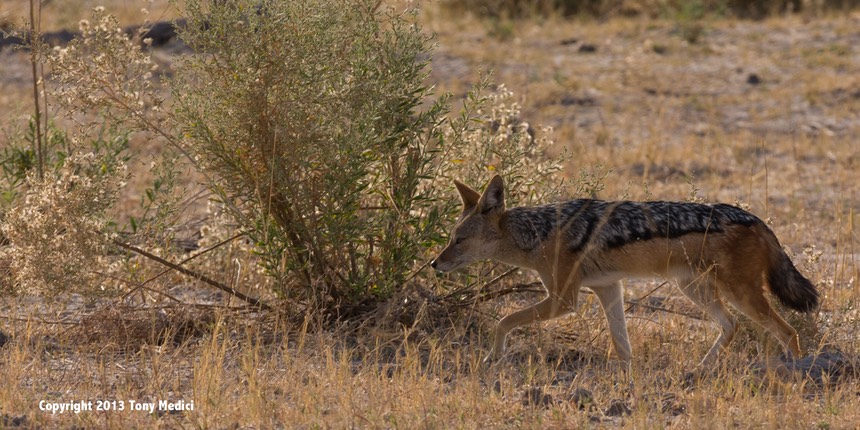

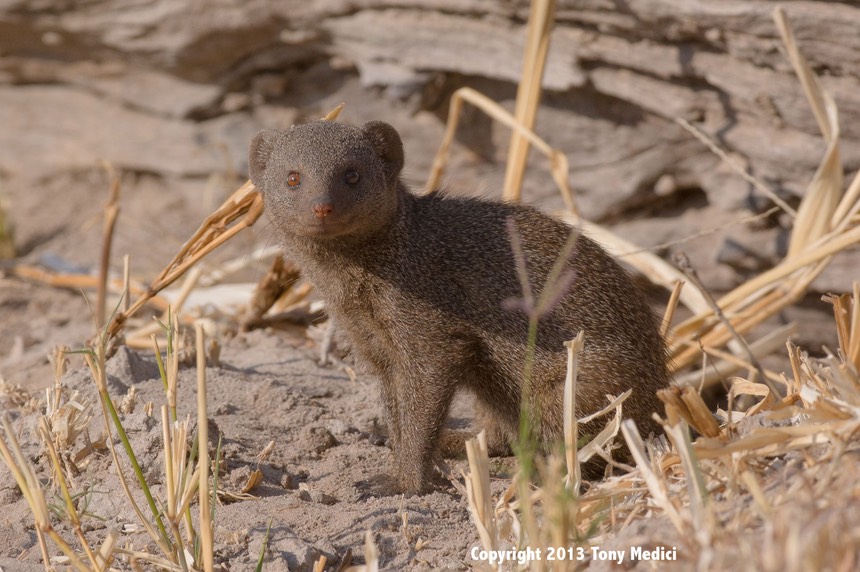
I mentioned it before, but it's worth repeating: the variety of wildlife you can shoot in the best places in Africa is astonishing. The above three shots were all taken during the pre-workshop scout, I think. Without students, there's no pressure on Tony and I to find another lion or leopard or wild dog. So if we come across just about anything, we'll stop and take the time to see what we might manage to get from it. Now these three critters are tough. The jackal tends to not like vehicles, and will just wander very far away from you unless there's something of great interest to them. The weasels and other small prey don't sit still very much or stay put long enough to shoot them most of the time, so when they do, you want to take advantage of that.
I have a funny story about that. I was following a pack of wolves in Denali once, and I knew they were heading back to the rendezvous point (if you didn't know that wolves have rendezvous points, you need to do some more homework before heading out to photograph them). So I raced ahead of them to try to find a great position to photograph them from. There was one little rise I was thinking of, so I moved ahead and set up there. And I followed the wolves as they came over the rise, ran in front of me right to left. I was clicking away on the alpha male when I became aware of a commotion behind him. When I chimped my sequence of shots, here's what I saw: wolves coming over the rise, wolves coming down the rise but there's a squirrel standing on its hind end looking on in terror at the left of my frame, then the male alpha passes the squirrel without even seeing it, but in the next frame the second male grabs the squirrel just at the far right edge of my frame as I'm still following the alpha.
The moral of the story is this: if Africa is giving you prey sitting around posing for you, there's a chance that a predator will take advantage of that.

I've included this photo for a reason. I'm in the right front of that vehicle. I don't have a shot (at least not without shooting through the windshield). One reason why I love Adam's vehicle so much is that the windshield folds down. Basically any time I'm with Adam, the windshield is down. He's so used to it now he just lowers it the minute I get in the vehicle, even if we have to drive through sand for awhile to get to anything. It's just another in those "be prepared" things you have to do. You don't want to get to a scene you want to photograph and have to wait for the windshield to be lowered.
Now, if I were in one of the other vehicles by myself, I'd probably be in the second row and out the top and sides for shooting. I've been known to just sit up top (not possible in all places due to regulations, and you need the right pads and position to do it at all). Obviously, I'm usually only up there when we're crawling along, but when we're night shooting and I'm manning the light, I'll often find a way to buckle in up there (all the vehicles have seat-like areas up top in three places). Being up high with the light is absolutely necessary at night.
I wrote earlier that this was the honey badger workshop. Boy did we see a lot of honey badgers. I hit 10, and I think Tony topped that:

See that pile of sand to the right of the badger? Tony was in another vehicle that came up after the digging started, so I don't think he saw it, but there was no sand there when the badger started digging. I'm still trying to figure this problem out: when the badger is digging, all you can see is just a huge dust cloud of sand. I tried several times, but you can't see the badger through the sand! So I have a shot I can envision, but haven't achieved yet. I'll be looking for that shot in 2014 when I return to Botswana.

Along those lines: when an animal has a name that translates to "cliff springer," then you probably ought to be looking to see if you can photograph him springing on a cliff. Adjectives and verbs and adverbs are always good when you're thinking about a shot. Too many photographers think "antelope." In other words, noun. This is an antelope that springs from rock to rock in a very small area. In other words, verb. Verbs are always better than nouns when you're photographing. What's the verb you're shooting?
Let's try another example from Tony's files:
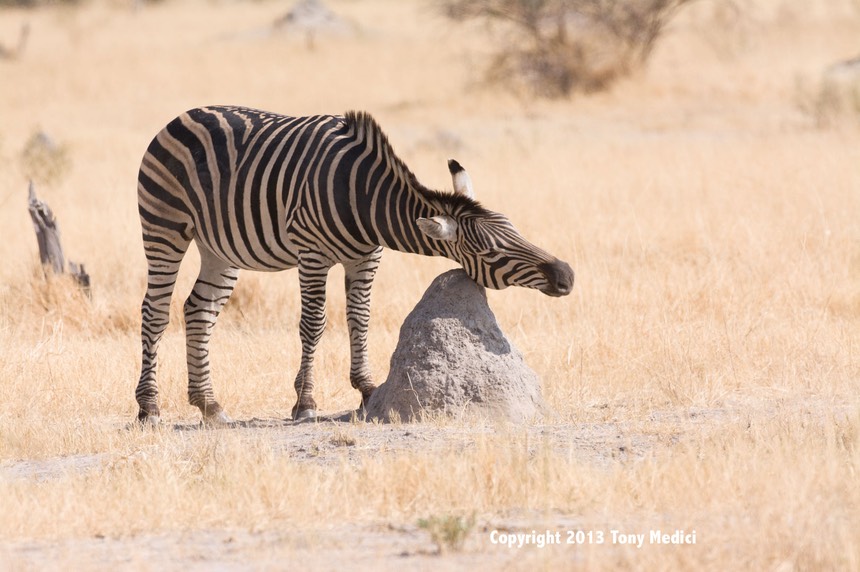
Scratchin' an itch. Actually, this zebra was more interesting when he was scratching his tummy with the termite mound. The only problem is that there was another zebra just behind him most of the time while he was doing that. Tony and I sat here on this and a couple of other zebra for quite some time. The zebras were "verbing" for us, so we stayed put.
Adjectives are good, too. What adjectives do you get out of these photos?

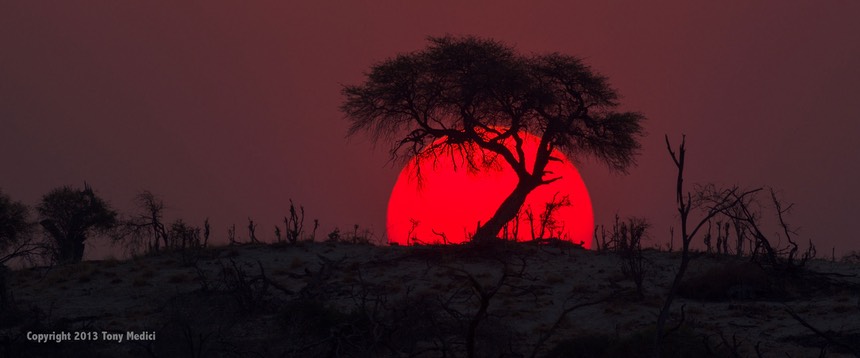
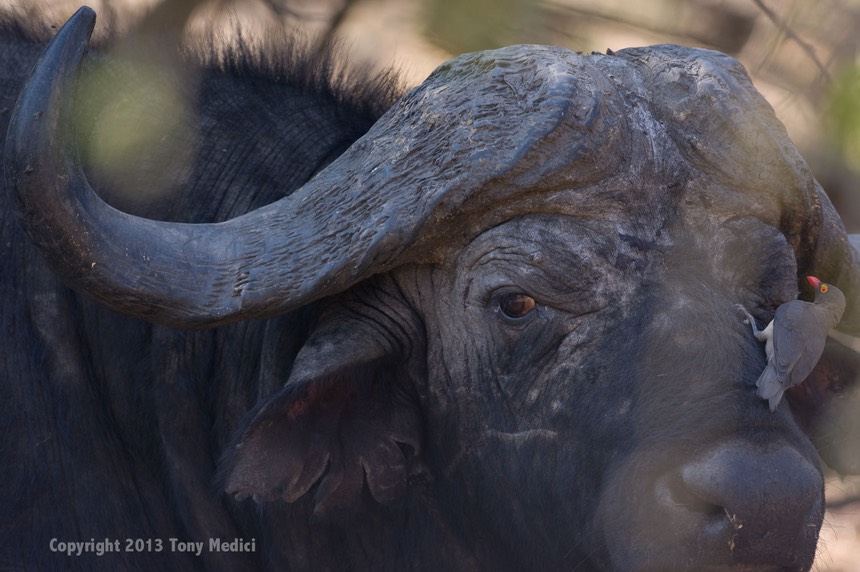
Tony gave me the next shot not to show off, but to help show you one of the things you often deal with in Africa (and which is causing the faintness on the right side of the above photo): lots of brush that obstructs the thing you want to take a picture of. Note also how some of the branches look like leopard's tail, complete with spots. When leopards want to disappear, they do so pretty darned well. But even when we find them, it's rare that we don't have more work to do. When confronted with the scene in this image, I have two things to figure out: where is the leopard likely to be going, if anywhere, and how can I get the vehicle positioned so that there's a good chance of getting a clean shot through an opening? That's one of those real time, multidimensional, constantly changing calculations. I've gotten better and better though the years at coming up with the solution, though.

I can't leave Tony's shooting on that note, so let me show you one of the things that Tony does quite well: working birds. If you come to one of my future workshops and both Tony and birds are around, spend some time with him and you'll find out how to do things like this:

That's a tough sequence to pull off. Very tough.